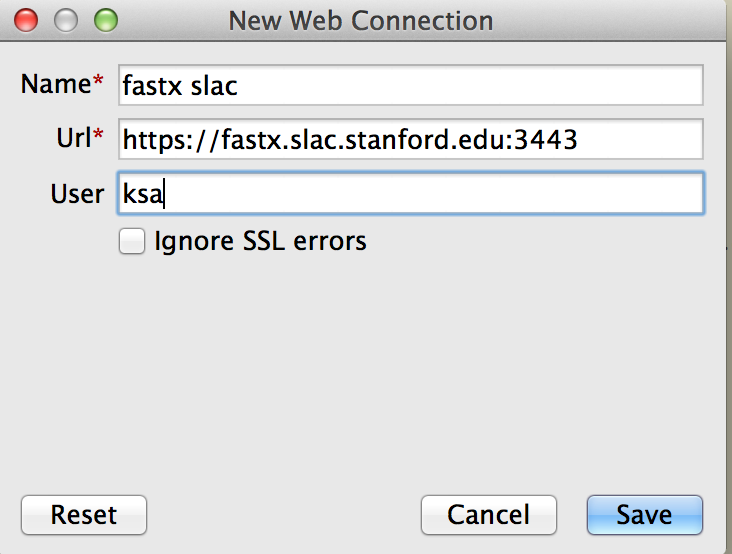...
The easiest way to use FastX is through your Web browser. All modern browsers are supported, including Firefox, Safari, Chrome, and IE 10+ (or your smart phone).
- Go to the SLAC FastX web login page: https://fastx.slac.stanford.edu:3443
- Log in with your SLAC Unix username and password.
Do not check the Public Key Authentication option – that will not work well since it will not give you an AFS token.
To start a new session, click on the plus box:
Inside the command box, you can start an xterm window and connect to a SLAC interactive login pool machine like this
(You can replace rhel6-64 with the hostname of your own group's interactive login machine if you have one):$ xterm -e ssh rhel6-64.slac.stanford.edu
When your xterm session starts, you may wish to start a lightweight window manager so you can resize and move windows around inside your browser window.
Starting a lightweight window manager is not required, but it's necessary if you want to move and resize your X Clients inside your browser window.
To do that, type these two commands inside your xterm window (the xsetroot command just makes your desktop background a more pleasing color):$ twm &
$ xsetroot -solid greyNow you can start your Linux X applications by typing the commands inside your xterm window. For example:
$ gimp &
$ firefox &
$ /afs/slac/package/anaconda/anaconda3/bin/spyder &As always, your SLAC Unix AFS token needs to be renewed every 25 hours. If your AFS token expires, then you will not be able to write files into your AFS home directory. When you reconnect to your session later, the 'qtoken' command will quickly tell you if you have a current AFS token or not. If your AFS token as expired, then use the 'kinit' command to get a new Kerberos ticket and AFS token.
$ /usr/local/bin/qtoken
$ /usr/local/bin/kinit
...
If you have an old version of the FastX desktop client, please delete it and download the latest version.
- Go to this URL: https://fastx.slac.stanford.edu:3443
- Click on the link that says: "Looking for the desktop client?"
- After you download and start the desktop client, click the + (plus) icon to configure a new sessionconnection.
- You can Next, select either " Web " (https port 3443) or " SSH " (ssh port 22) when given the choices of Web or SSH. Both are encrypted and secure, and either choice should work well.
- Enter these values if you create a new SSH sessionconnection: (replace 'ksa' with your username):
- Enter these values when if you create a new WEB Web client sessionconnection: (replace 'ksa' with your username):
- Click the Save button.
- Double click on your new saved sessionconnection.
- You can start a new session using the same instructions the the above session for "Connecting to FastX" – click the + (plus) icon.
- When you start a new session using the desktop client, you have a choice for Window mode: Multiple or Single.
Multiple window mode means that your remote Linux application will appear as a seamless (standalone, separate) window on your desktop, and any additional Linux X applications you start from the same session will also appear as seamless windows on your desktop. So, "Multiple mode" means you will see multiple windows on your desktop for each remote Linux application you start in this one session. Multiple mode works well if you only use the desktop client and do not plan to use your web browser to access this session in the future. If you want the option to connect to your session in the future using your web browser, then you should choose Single Window mode. With Single Window modesingle window mode, all of your Linux X applications will be run within inside one larger resizable single window (as opposed to the multiple seamless floating windows you get if you choose multiple mode). The single larger window (if you run in Single Window mode) can be run in full screen mode for maximum resolution. After you start your session, just maximize the single window. Whenever you maximize or resize your single FastX window, you should then tell FastX to resize your screen so you get the maximum resolution. To do that, hover your mouse pointer over middle of the top of the single window. You will see several icons – one of them is to tell FastX to resize your window.
You can reconnect to one of your already running sessions by double clicking on it under the Name column. It may could take many several seconds for your saved session to appear.
You should also see any sessions you already have running that you may have started in a browser connection to FastX.
...

